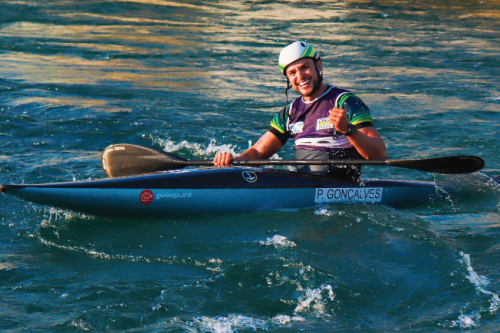
Will it all fit in? How to pack a sea kayak…

Escaping from it all and being immersed in the environment with that feeling of not a care in the world; that is surely what going away on a sea kayaking trip is all about. As true as this is, the lead up to this unique experience can be quite a different experience – which for many will have us waking up at night in a cold sweat! It will often start at home with ‘what will I take?’ and ‘will it all fit?’ and then culminate at the launch site with ‘how do I get it all in my kayak?’ and ‘where should I put it?’. All being well this will conclude with a ‘packing done’ celebration (we can all relate to that!); but over the years I have also experienced the ‘it doesn’t fit horror’ which leads to what must I leave behind; or it all fits but is all in the wrong place and a constant re-shuffle and distribution of kit is required during the trip. So, reflecting on my kayak packing successes and failures, here are some ‘kit packing words of wisdom’ – to hopefully alleviate some of the cold sweats and help with a smoother transition to the packing done celebration.

Type of trip – lightweight or luxury
A starting point for me is to decide does the trip planned necessitate the kit being lightweight and compact as possible, or is it a luxury trip where we want all the comforts possible? If it is a ‘weekender’ then the luxury option should be more than viable; but if out for a week or more then light is right! Getting the type of trip agreed at the start will inform the kit to get together and this in turn ensures we will be able to pack it.
Kit
If going ‘luxury’ then perhaps decide what you want to be luxurious! For me that is usually food and camp comfort; with this in mind I still go light and compact on some things (clothing, sleeping bag, mat, stove) to prioritise space for food, drink, camp chair, book and duvet jacket. So even when going luxury – look for where you can save space without overall compromise as there is only so much you can fit in! If going lightweight and compact, then I find food and clothing is usually where I can save most space. One set of paddling clothes and this then topped up with a few additional camp clothes, one set of shoes for paddling & camp (assuming they are wet after paddling using waterproof socks as camp socks inside paddling shoes for ashore). Food wise then I make all my own vacuum packed dehydrated food, so healthy, tasty and packs down to nothing; also uses minimum fuel so further weight/space saving. So, as you invest in your kit look to get light and compact wherever you can to give the best options.

Packing
Dry bags – this is perhaps the main way to ensure a ‘packing done celebration’. Have lots of smaller dry bags that are made of a softer material, as opposed to large robust dry bags. With these dry bags think about the shape of them as well, looking for those that can fit into the small spaces in the kayak. Have a label or colour coding system to the know what is in each dry bag to avoid the ‘guess the dry bag’ game that can get frustrating at the end of a long day when getting unpacked in the rain!
Kit for awkward spaces – the bow, stern and around the skeg box are all places where a lot of packing space can be wasted or gained. Plan to fill these spaces with specific kit that can maximise these spaces, for me this is often fuel containers, tent poles, sleeping matt, camp chair, rubbish, washing kit, small food bags and of course bottles of wine/whisky!

Accessibility – think about what kit you will need accessible on the water, when you land for a break during the day, and when you land to set up camp. For the camp kit, again think what will you need every night and what will you need ‘just in case’ or if things run out (fuel, food items, stove/camp repair kit). This all considered pack accordingly – so you never have to empty everything out to get something you need at an inappropriate time.
Trim - Being aware that where things are packed can affect the trim is essential; this all impacts on the paddling performance of your boat. Get this wrong and it will be the surest way to lead to a miserable trip – if the boat is feeling ‘hard work’ in the wind, then chances are you’ve got the trim wrong when packing and it needs changing. For a general rule I’d suggest try and pack neutral or slightly stern heavy (thus heaviest items in bulkhead just behind cockpit). A top tip here is to use the water you will be carrying as ‘moveable ballast’; thus, if you get it wrong it is just the water container/s you shift in the kayak to correct it. Or, if the conditions change during the day, you can move the water container/s to maximise performance.

Gaining ‘extra’ space’ – Once the storage hatches are full – don’t panic! There is often a lot of storage opportunities in the cockpit where kit can be safely stored. In front of the footrests is often a large area of ‘unused space’, where I will often store the tent in a robust drybag that once squeezed in will not come out in event of capsize. Behind the seat is another space that can be utilized for additional storage, perhaps clipping dry bags in for security/safety. Well-fitting and secured deck storage bags are also a possibility, if going down this line ones that are as low lying as possible are best so they don’t catch the wind too much. I would generally suggest this is a ‘last case’ option though and aim to fit everything in the kayak. Deck storage always has the potential to compromise paddling performance/efficiency and make rescues/rolling harder.

Packing in action - When it comes to actually loading the kayak; then always think about minimizing the need to carry a heavy loaded kayak. Be aware of if the tide is coming in or out, and then pack the kayak as close to the water as possible. Carry the empty (less packed) kayak to the water and then carry the kit separately to the kayak for packing; a kit carrying bag is invaluable for this (the good old Ikea bag used by many!)
Packing efficiency - When on a trip then it is all well and good the kayak being packed well, but are you being as efficient as possible to aid the packing process? Each evening, are you able to just bring ‘essential’ things up to camp; or are you having to completely unpack everything each time? I tend to have my food set out in ‘day packs’ thus I only need to grab food for the day as opposed to sort through all the food every time. When getting ready in the morning I will pre-pack the dry bags as I go, thus they are then ready to carry down to the kayak for packing when needed. All these little things will help minimize the packing ‘faff’ and associated stress!

Packing done – let’s celebrate! - Considering the above and with a bit of forethought, then hopefully every trip can be about a celebration of packing, as opposed to will it all fit stress! The mornings can become a relaxed seamless and enjoyable process; as opposed to pressured, rushed and all with fingers crossed process. The question of ‘will it all fit?’ will change to a statement of ‘yes, it will fit’; and with that I’ll leave you to get out on some kayaking trips and embrace the packing experience – good luck!










